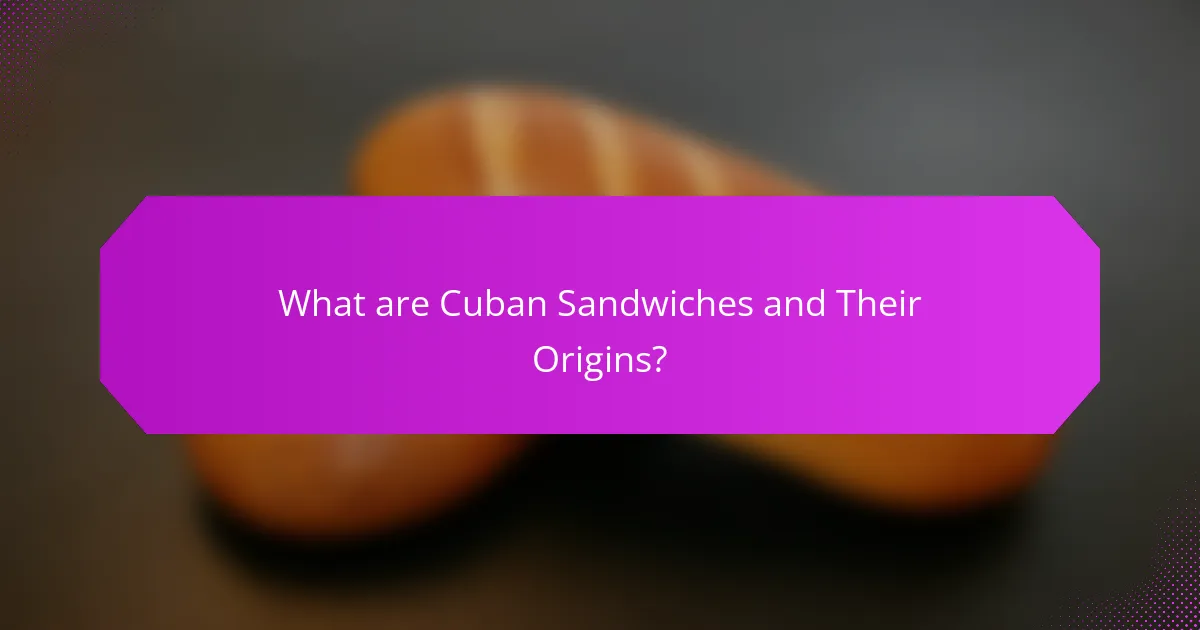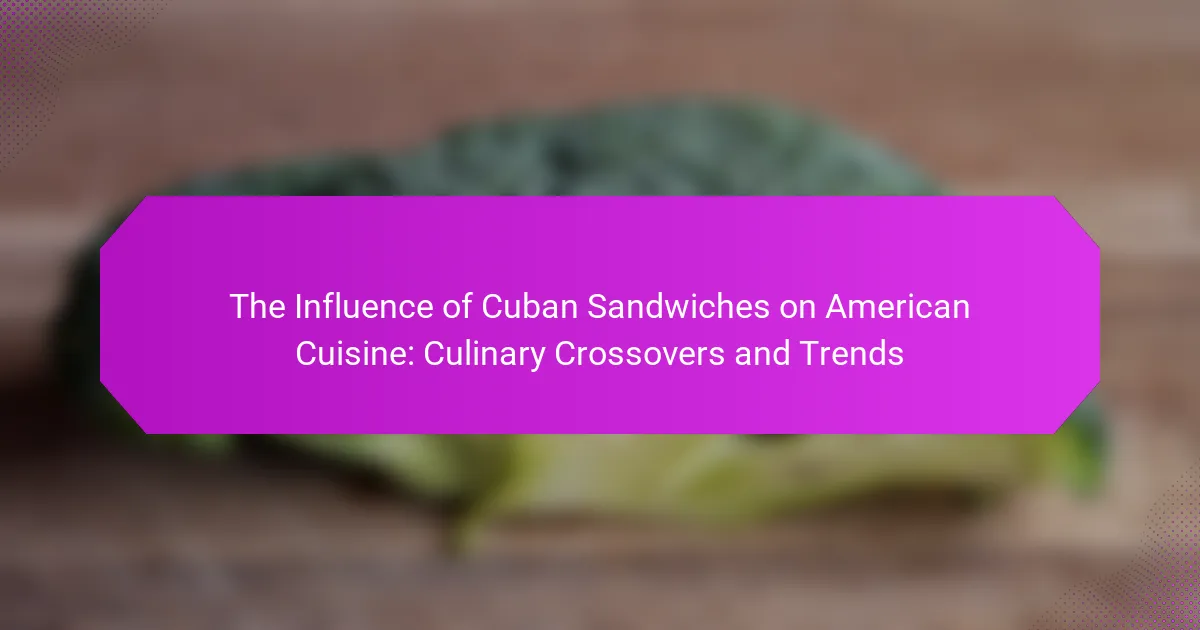Cuban sandwiches are a pressed sandwich originating from Cuba, typically made with Cuban bread, roasted pork, ham, Swiss cheese, pickles, and mustard. This sandwich has gained popularity in the United States, particularly in Florida, due to Cuban immigration in the early 20th century, and it represents a fusion of Cuban and American culinary traditions. Cuban sandwiches have influenced American cuisine by introducing new flavors and techniques, inspiring variations that incorporate local ingredients across different regions. The rise of food trucks and casual dining has further spread their appeal, while social media has played a significant role in promoting these culinary trends. As a result, Cuban sandwiches are increasingly recognized for their role in enhancing the diversity of American dining experiences.

What are Cuban Sandwiches and Their Origins?
Cuban sandwiches are a type of pressed sandwich originating from Cuba. They typically consist of Cuban bread, roasted pork, ham, Swiss cheese, pickles, and mustard. The sandwich is characterized by its crispy crust and warm, melty filling. Cuban sandwiches gained popularity in the United States, especially in Florida, due to Cuban immigration in the early 20th century. The sandwich reflects a blend of Cuban and American culinary traditions. In particular, it showcases the influence of Cuban flavors on American cuisine. The first documented Cuban sandwich in the U.S. appeared in Tampa around the 1900s. Today, they are widely enjoyed across the country, symbolizing cultural exchange.
How did Cuban Sandwiches become popular in America?
Cuban sandwiches became popular in America primarily through the influence of Cuban immigrants. The sandwich, which includes Cuban bread, roasted pork, ham, Swiss cheese, pickles, and mustard, originated in Cuba. Its introduction to the U.S. began in the late 19th and early 20th centuries. Many Cubans settled in Florida, particularly in Tampa and Miami. These cities became cultural hubs for Cuban cuisine. The sandwich gained attention in the 1960s as Cuban culture spread. Food enthusiasts and chefs began to recognize its unique flavors. Today, Cuban sandwiches are featured in restaurants across the country. This popularity reflects the broader acceptance of diverse culinary traditions in American cuisine.
What key ingredients define a traditional Cuban Sandwich?
A traditional Cuban sandwich is defined by key ingredients that include Cuban bread, roasted pork, ham, Swiss cheese, pickles, and mustard. Cuban bread is a unique, soft bread that is essential for the sandwich’s structure. Roasted pork is marinated in a citrus-garlic sauce, providing rich flavor. Ham adds a savory layer, complementing the pork. Swiss cheese melts beautifully, creating a creamy texture. Pickles introduce a tangy contrast, while mustard adds zest. Together, these ingredients create a harmonious blend that defines the Cuban sandwich’s distinct taste.
How do regional variations of Cuban Sandwiches differ?
Regional variations of Cuban sandwiches differ primarily in ingredient composition and preparation methods. In Florida, the Cuban sandwich typically includes roasted pork, ham, Swiss cheese, pickles, and mustard, pressed in a Cuban bread. In Tampa, a unique variation incorporates Genoa salami, reflecting the city’s Italian influence. In Miami, the sandwich is often made with a more straightforward approach, sticking closely to traditional Cuban ingredients without additional meats. Additionally, some regions may vary the type of bread used, with some opting for a softer or crustier texture. These regional adaptations highlight the cultural influences and local tastes that shape the Cuban sandwich across the United States.
What cultural influences shaped the Cuban Sandwich?
The Cuban Sandwich is shaped by Spanish, Cuban, and Caribbean cultural influences. Spanish immigrants introduced ingredients like cured meats and cheese. Cuban culinary traditions contributed to the use of roasted pork and pickles. The Caribbean influence is evident in the sandwich’s use of tropical flavors and spices. This blend reflects the diverse cultural heritage of Cuba. The Cuban Sandwich became popular in Tampa and Miami, showcasing its regional significance. Its evolution represents a fusion of these distinct culinary traditions.
How did immigration contribute to the spread of Cuban Sandwiches?
Immigration significantly contributed to the spread of Cuban sandwiches in the United States. Cuban immigrants brought their culinary traditions to Florida, particularly to cities like Miami. As these immigrants settled, they introduced the Cuban sandwich, which combines Cuban bread, roasted pork, ham, Swiss cheese, pickles, and mustard. The growing Cuban population in Florida helped popularize this dish in local eateries and restaurants. Over time, the Cuban sandwich became a staple in Cuban-American cuisine. Its popularity expanded beyond the Cuban community, attracting diverse diners. The sandwich’s presence in food festivals and media further fueled its recognition. Today, Cuban sandwiches are enjoyed nationwide, symbolizing the cultural exchange resulting from immigration.
What role did Cuban cuisine play in American culinary history?
Cuban cuisine significantly influenced American culinary history by introducing diverse flavors and cooking techniques. The arrival of Cuban immigrants in the early 20th century brought dishes like the Cuban sandwich and ropa vieja to the U.S. These dishes showcased the fusion of Spanish, African, and Caribbean influences. The Cuban sandwich, in particular, became a staple in cities like Miami and Tampa. It features layers of roasted pork, ham, Swiss cheese, pickles, and mustard on Cuban bread. This sandwich reflects the cultural melting pot of Florida’s culinary scene. Additionally, Cuban cuisine popularized ingredients such as plantains and black beans in American cooking. The vibrant flavors and unique combinations have had a lasting impact on regional American dishes.

How have Cuban Sandwiches influenced American Cuisine?
Cuban sandwiches have significantly influenced American cuisine by introducing new flavors and culinary techniques. This sandwich combines elements from Cuban, Spanish, and American culinary traditions. The use of marinated pork, Swiss cheese, pickles, and mustard has become popular in various American deli and sandwich shops.
Cuban sandwiches have inspired fusion cuisine, leading to variations that incorporate local ingredients and flavors. For example, many American cities now feature their own takes on the Cuban sandwich, adapting it to regional tastes. The sandwich’s popularity has also sparked interest in other Cuban dishes, further integrating Cuban culinary influences into American dining.
Additionally, the rise of food trucks and casual dining has facilitated the spread of Cuban sandwiches across the United States. The sandwich’s presence in major cities like Miami, New York, and Los Angeles highlights its role in the broader narrative of American food culture.
What culinary trends have emerged from Cuban Sandwiches?
Cuban sandwiches have influenced several culinary trends in American cuisine. Their popularity has led to a rise in fusion sandwiches that combine diverse cultural ingredients. Chefs are experimenting with traditional Cuban elements like marinated pork and pickles in new contexts. This trend includes incorporating Cuban flavors into other sandwich types, such as using Cuban bread with Italian meats. The emphasis on authentic, high-quality ingredients has also increased. Many restaurants are now focusing on sourcing local and organic components. Additionally, the Cuban sandwich has inspired food trucks and casual dining spots to feature it as a signature item. This has contributed to the growth of the sandwich culture in urban areas across the United States.
How have chefs incorporated Cuban Sandwich elements into their menus?
Chefs have incorporated Cuban Sandwich elements into their menus by integrating its key ingredients and flavors. Common elements include roasted pork, ham, Swiss cheese, pickles, and mustard. These ingredients are often featured in various forms, such as sliders or gourmet sandwiches. Many chefs experiment by adding unique twists, like using different types of bread or additional toppings. Some restaurants offer Cuban-inspired bowls, combining sandwich components with rice or greens. The popularity of Cuban sandwiches has led to fusion dishes that blend them with other cuisines. This culinary trend reflects the growing appreciation for diverse flavors in American cuisine. Chefs utilize these elements to create innovative dining experiences that pay homage to the traditional Cuban sandwich.
What fusion dishes have been inspired by the Cuban Sandwich?
Fusion dishes inspired by the Cuban Sandwich include the Cuban-Style Sliders. These feature mini versions of the traditional sandwich, often served at parties. Another example is the Cuban Sandwich Pizza, which combines pizza dough with Cuban sandwich toppings. The Cuban Quesadilla is also popular, incorporating the sandwich’s flavors into a tortilla format. Additionally, the Cuban Wrap offers a portable version, using flatbreads instead of bread. These dishes showcase the versatility of the Cuban Sandwich in modern cuisine.
Why are Cuban Sandwiches considered a symbol of culinary crossover?
Cuban sandwiches are considered a symbol of culinary crossover due to their blend of diverse cultural influences. They combine elements from Cuban, Spanish, and American cuisines. The sandwich typically features Cuban bread, roast pork, ham, Swiss cheese, pickles, and mustard. This combination showcases the fusion of flavors and techniques from different culinary traditions. Historically, Cuban immigrants brought their culinary practices to the United States. The sandwich gained popularity in Florida, particularly in Miami. This reflects the adaptation of traditional recipes to local tastes and ingredients. The Cuban sandwich exemplifies how food can bridge cultural divides and create new culinary identities.
How do Cuban Sandwiches reflect the melting pot of American culture?
Cuban sandwiches reflect the melting pot of American culture through their diverse ingredients and origins. The sandwich combines elements from Cuban, Spanish, and American culinary traditions. It features Cuban bread, which is a staple in Cuban cuisine. The filling typically includes roast pork, ham, Swiss cheese, pickles, and mustard. Each ingredient represents cultural influences that have shaped American food. For example, roast pork reflects Spanish cooking techniques. The use of Swiss cheese highlights European dairy traditions. The sandwich’s popularity in Florida, particularly in Miami, underscores the influence of Cuban immigrants. This blend of flavors and cultures showcases the integration of various ethnicities in American society. Cuban sandwiches serve as a delicious symbol of cultural fusion in the United States.
What are the social implications of Cuban Sandwich popularity?
The popularity of Cuban sandwiches has significant social implications. It reflects the growing acceptance of diverse culinary traditions in American society. This acceptance fosters cultural exchange and appreciation among different ethnic groups. The Cuban sandwich serves as a symbol of Miami’s multicultural identity. Its rise in popularity also supports local economies, particularly in areas with Cuban-American communities. Increased demand for Cuban sandwiches can lead to more authentic restaurants and food trucks. This trend encourages the preservation of traditional recipes and cooking methods. Overall, the popularity of Cuban sandwiches promotes social cohesion through shared culinary experiences.

What are the current trends surrounding Cuban Sandwiches in America?
Cuban sandwiches are increasingly popular in America, reflecting a growing interest in diverse culinary experiences. Many restaurants are elevating the traditional Cuban sandwich with gourmet ingredients. This includes artisanal bread, house-made pickles, and specialty meats. Food trucks and casual dining spots are also featuring unique takes on the classic recipe. Additionally, the rise of fusion cuisine is leading to innovative variations, combining Cuban flavors with other culinary traditions. Social media plays a significant role in promoting these trends, with vibrant food photography attracting attention. Furthermore, the demand for authentic Cuban sandwiches has led to an increase in specialty shops dedicated to this dish. Overall, the trend showcases a blend of tradition and modern culinary creativity.
How are modern interpretations of Cuban Sandwiches evolving?
Modern interpretations of Cuban sandwiches are evolving through innovative ingredients and diverse culinary techniques. Chefs are experimenting with different proteins, including fried chicken and plant-based options. These variations cater to dietary preferences and trends, such as vegetarianism and veganism. Additionally, some interpretations incorporate unique sauces and toppings, enhancing flavor profiles. The bread used is also being adapted, with options like ciabatta or sourdough emerging. Regional influences are reshaping the sandwich, with local ingredients being integrated into traditional recipes. This evolution reflects a broader trend in American cuisine towards fusion and creativity. The Cuban sandwich continues to adapt while maintaining its cultural roots.
What innovative ingredients are being used in contemporary Cuban Sandwiches?
Contemporary Cuban sandwiches are incorporating innovative ingredients such as avocado, pickled jalapeños, and artisanal cheeses. These additions enhance the traditional flavor profile. Avocado provides creaminess and a fresh taste. Pickled jalapeños add a spicy kick that contrasts with the savory meats. Artisanal cheeses, like aged Gouda or pepper jack, introduce unique textures and flavors. Additionally, some variations include specialty mustards or gourmet spreads. These modern twists reflect evolving culinary trends while honoring the original sandwich’s essence.
How are health trends impacting the traditional Cuban Sandwich recipe?
Health trends are leading to modifications in the traditional Cuban Sandwich recipe. Many consumers are seeking healthier options due to rising health awareness. This has resulted in the reduction of fatty meats traditionally used in the sandwich. Leaner proteins like turkey or grilled vegetables are now common substitutes. Additionally, whole grain or gluten-free bread is becoming popular among health-conscious diners.
The use of less cheese and healthier condiments is also on the rise. These changes aim to lower calorie counts and improve nutritional value. As a result, traditional Cuban Sandwiches are evolving to meet modern dietary preferences. This reflects a broader trend in American cuisine, where health considerations increasingly influence classic recipes.
What are the best practices for making an authentic Cuban Sandwich?
To make an authentic Cuban sandwich, use Cuban bread as the base. This bread is essential for the sandwich’s texture and flavor. Layer roasted pork, ham, Swiss cheese, and pickles inside the bread. The combination of these ingredients creates the traditional taste. Spread yellow mustard on the inside for added flavor. Press the sandwich in a plancha or a sandwich press until the bread is crispy. The pressing melds the flavors and warms the ingredients thoroughly. Serve the sandwich hot for the best experience. Authentic Cuban sandwiches originated in Cuba and are now popular in various regions, especially in Florida.
How can home cooks replicate the flavors of a traditional Cuban Sandwich?
Home cooks can replicate the flavors of a traditional Cuban sandwich by using key ingredients and techniques. A Cuban sandwich typically includes roasted pork, ham, Swiss cheese, pickles, and mustard on Cuban bread. The pork should be marinated with citrus juices, garlic, and spices to achieve authentic flavor.
Cooking the pork slowly allows it to become tender and flavorful. The sandwich is assembled with layers of meat and cheese, then pressed and grilled to create a crispy exterior. Using Cuban bread is essential, as its texture and flavor contribute to the overall experience.
To enhance the taste, home cooks can add a touch of butter to the outside of the bread before grilling. This creates a golden crust and adds richness. The combination of tangy pickles and sharp mustard balances the richness of the meats and cheese.
The Cuban sandwich’s origins trace back to Cuban immigrants in Florida, showcasing its cultural significance. Following these steps will help home cooks achieve an authentic taste reminiscent of traditional Cuban sandwiches.
What tips can enhance the overall experience of enjoying a Cuban Sandwich?
To enhance the overall experience of enjoying a Cuban sandwich, focus on quality ingredients. Use fresh Cuban bread for the best texture and flavor. Layer authentic meats like roasted pork, ham, and salami for a traditional taste. Include Swiss cheese and pickles to complement the meats. Press the sandwich on a grill to achieve a crispy exterior and warm interior. Pair the sandwich with a side of plantain chips or a refreshing mojito. Serve it hot for optimal enjoyment. These practices ensure a satisfying and authentic Cuban sandwich experience.
The main entity of the article is Cuban sandwiches, a pressed sandwich that originated in Cuba and features key ingredients such as Cuban bread, roasted pork, ham, Swiss cheese, pickles, and mustard. The article explores the historical roots of Cuban sandwiches in the U.S., highlighting their rise in popularity due to Cuban immigration and cultural exchange, especially in Florida. It examines the key ingredients that define traditional Cuban sandwiches, regional variations, and the cultural influences that shaped them. Additionally, the article discusses the impact of Cuban sandwiches on American cuisine, emerging culinary trends, and innovative adaptations that reflect modern dietary preferences.
